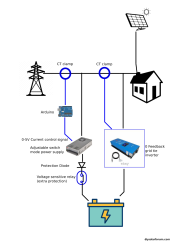Hello! just wanted to get some thoughts on a project.
Problem: Adding a battery to house, there is a pre existing solar array which for regulation reasons can not be touched, but i want to make use it to help charge the House battery (other solar will be added but that's not relevant to the problem)
Market solutions for this exist but involve a lot of money and isolating house from grid
Solution: for a DIY solar diverter to battery. There are tonnes of solar diverters out there but most only work with hot water or by simply turning on some device when power exporting reaches a threshold. Rubbish IMHO, I would like a continuous power redirection and to capture that in a Battery. I think I have thought about a relatively cheap and easy way to build a DIY diverter for charging a battery bank. Basic concept: Big adjustable power supply that takes a 0-5V current control input (they exist and are cheap), running in Constant Current mode, max voltage set to max safe voltage of battery, Max current controlled by an arduino. The arduino measures the power going into and out of house using either a bidirectional power meter (CT clamp combined with Voltage measurement https://youtu.be/DWELwaMy2CQ?si=hedasl-GTkJAplBq&t=181) or 2 CT clamps. one on solar output the other on house. Connect Power supply to house side of clamp. Then use a PID library running on the Arduino (I have used before, both simple and effective) to adjust the power supply current and put the setpoint for the current leaving the house to 0. This would allow a continuously adjustable solar diverter able to push power efficiently into battery. I would introduce a chunky 100A diode between supply and battery. BMS should prevent over voltage of battery in fault but a voltage thresholded relay might be a nice reassurance.
Example of DC power supply:
https://www.aliexpress.com/item/1005005622031474.html?spm=a2g0o.detail.0.0.64c4NrCZNrCZgN&gps-id=pcDetailTopMoreOtherSeller&scm=1007.40000.327270.0&scm_id=1007.40000.327270.0&scm-url=1007.40000.327270.0&pvid=761dbe07-d065-4b29-b06f-5d37bc8d40c6&_t=gps-id cDetailTopMoreOtherSeller,scm-url:1007.40000.327270.0,pvid:761dbe07-d065-4b29-b06f-5d37bc8d40c6,tpp_buckets:668%232846%238116%232002&pdp_npi=4%40dis%21CAD%21607.43%21425.2%21%21%213183.58%21%21%402103200516940245753271015e125c%2112000033778837354%21rec%21CA%21%21A
cDetailTopMoreOtherSeller,scm-url:1007.40000.327270.0,pvid:761dbe07-d065-4b29-b06f-5d37bc8d40c6,tpp_buckets:668%232846%238116%232002&pdp_npi=4%40dis%21CAD%21607.43%21425.2%21%21%213183.58%21%21%402103200516940245753271015e125c%2112000033778837354%21rec%21CA%21%21A
To Complete the setup I could connect my battery to my house's circuit with a zero feedback inverter like this one:
https://amzn.to/2SZzpbM
Nice Vid of how that inverter works:
https://www.youtube.com/watch?v=FZ0FwW2pRj8
This seems like a common problem and this solutions seems easy and cheap without many downsides to me so my main concern is why isnt this already a thing? am i missing some big problem? thoughts appreciated. Obviously there are some nuances i haven't gone into to keep the post short but the concept seems sound to me?
Problem: Adding a battery to house, there is a pre existing solar array which for regulation reasons can not be touched, but i want to make use it to help charge the House battery (other solar will be added but that's not relevant to the problem)
Market solutions for this exist but involve a lot of money and isolating house from grid
Solution: for a DIY solar diverter to battery. There are tonnes of solar diverters out there but most only work with hot water or by simply turning on some device when power exporting reaches a threshold. Rubbish IMHO, I would like a continuous power redirection and to capture that in a Battery. I think I have thought about a relatively cheap and easy way to build a DIY diverter for charging a battery bank. Basic concept: Big adjustable power supply that takes a 0-5V current control input (they exist and are cheap), running in Constant Current mode, max voltage set to max safe voltage of battery, Max current controlled by an arduino. The arduino measures the power going into and out of house using either a bidirectional power meter (CT clamp combined with Voltage measurement https://youtu.be/DWELwaMy2CQ?si=hedasl-GTkJAplBq&t=181) or 2 CT clamps. one on solar output the other on house. Connect Power supply to house side of clamp. Then use a PID library running on the Arduino (I have used before, both simple and effective) to adjust the power supply current and put the setpoint for the current leaving the house to 0. This would allow a continuously adjustable solar diverter able to push power efficiently into battery. I would introduce a chunky 100A diode between supply and battery. BMS should prevent over voltage of battery in fault but a voltage thresholded relay might be a nice reassurance.
Example of DC power supply:
https://www.aliexpress.com/item/1005005622031474.html?spm=a2g0o.detail.0.0.64c4NrCZNrCZgN&gps-id=pcDetailTopMoreOtherSeller&scm=1007.40000.327270.0&scm_id=1007.40000.327270.0&scm-url=1007.40000.327270.0&pvid=761dbe07-d065-4b29-b06f-5d37bc8d40c6&_t=gps-id
To Complete the setup I could connect my battery to my house's circuit with a zero feedback inverter like this one:
https://amzn.to/2SZzpbM
Nice Vid of how that inverter works:
https://www.youtube.com/watch?v=FZ0FwW2pRj8
This seems like a common problem and this solutions seems easy and cheap without many downsides to me so my main concern is why isnt this already a thing? am i missing some big problem? thoughts appreciated. Obviously there are some nuances i haven't gone into to keep the post short but the concept seems sound to me?



